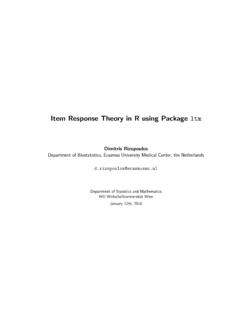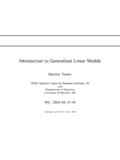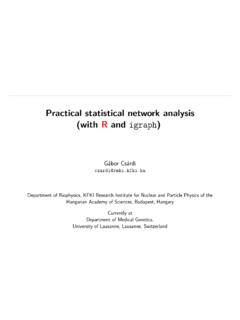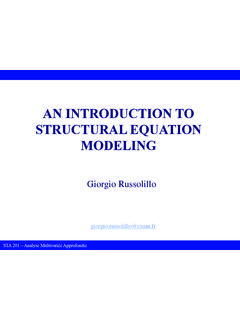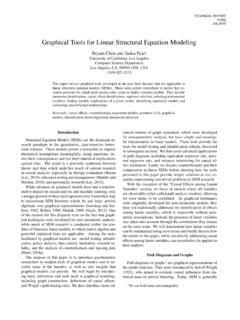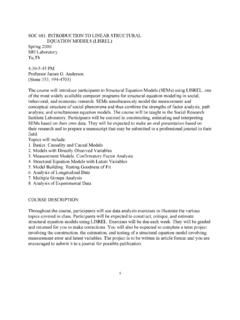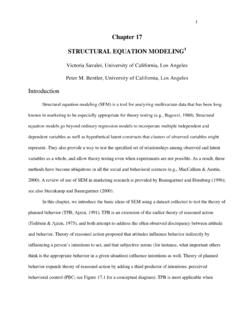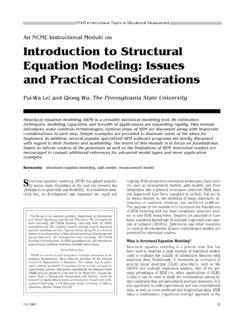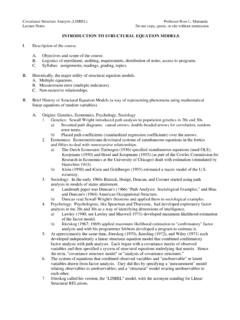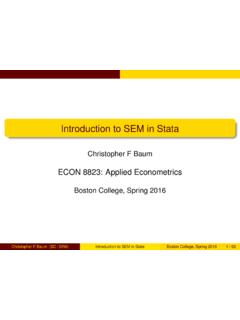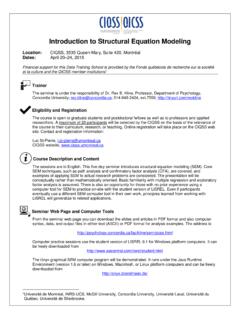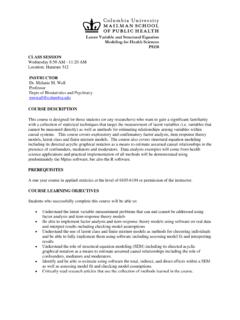Transcription of Introduction to Structural Equation Modelling
1 Applied Statistics With R Introduction to Structural Equation Modelling John Fox WU Wien May/June 2006 2006 by John Fox Introduction to Structural - Equation Modelling11. Introduction Structural - Equation models(SEMs) are multiple- Equation regressionmodels in which the response variable in one regression Equation canappear as an explanatory variable in another Equation . Indeed, two variables in an SEM can even affect one-anotherreciprocally, either directly, or indirectly through a feedback loop. Structural - Equation models can include variables that are not measureddirectly, but rather indirectly through their effects (calledindicators)or,sometimes, through their observable causes.
2 Unmeasured variables are variously termedlatent variables,con-structs,orfactors. Modern Structural - Equation methods represent a confluence of work inmany disciplines, including biostatistics, econometrics, psychometrics,and social statistics. The general synthesis of these various traditionsdates to the late 1960s and early FoxWU Wien May/June 2006 Introduction to Structural - Equation Modelling2 This Introduction to SEMs takes up several topics: The form and specification of observed-variables SEMs. Instrumental variables estimation. The identification problem : Determining whether or not an SEM,once specified, can be estimated.
3 Estimation of observed-variable SEMs. Structural - Equation models with latent variables, measurement errors,and multiple indicators. The LISREL model: A general Structural - Equation model with latentvariables. We will estimate SEMs using thesempackage in FoxWU Wien May/June 2006 Introduction to Structural - Equation Modelling32. Specification of Structural -EquationModels Structural - Equation models are multiple- Equation regression modelsrepresenting putative causal (and hencestructural) relationships amonga number of variables, some of which may affect one another mutually. Claiming that a relationship is causal based on observational data isno less problematic in an SEM than it is in a single- Equation regressionmodel.
4 Such a claim is intrinsically problematic and requires support beyondthe data at FoxWU Wien May/June 2006 Introduction to Structural - Equation Modelling4 Several classes of variables appears in SEMs: Endogenous variablesare the response variables of the model. There is onestructural Equation (regression Equation ) for eachendogenous variable. An endogenous variable may, however, also appear as an explana-tory variable in other Structural equations . For the kinds of models that we will consider, the endogenousvariables are (as in the single- Equation linear model) quantitativecontinuous variables. Exogenous variablesappear only as explanatory variables in thestructural equations .
5 The values of exogenous variables are therefore determined outsideof the model (hence the term). Like the explanatory variables in a linear model, exogenous variablesare assumed to be measured without error (but see the laterdiscussion of latent-variable models).John FoxWU Wien May/June 2006 Introduction to Structural - Equation Modelling5 Exogenous variables can be categorical (represented, as in a linearmodel, by dummy regressors or other sorts of contrasts). Structural errors(ordisturbances) represent the aggregated omittedcauses of the endogenous variables, along with measurement error(and possibly intrinsic randomness) in the endogenous variables.
6 There is one error variable for each endogenous variable (and hencefor each Structural Equation ). Theerrorsareassumedtohavezeroexpectation sandtobeindependent of (or at least uncorrelated with) the exogenousvariables. The errors for different observations are assumed to be independentof one another, but (depending upon the form of the model) differenterrors for the same observation may be FoxWU Wien May/June 2006 Introduction to Structural - Equation Modelling6 Each error variable is assumed to have constant variance acrossobservations, although different error variables generally will havedifferent variances (and indeed different units of measurement the square units of the corresponding endogenous variables).
7 As in linear models, we will sometimes assume that the errors arenormally distributed. I will use the following notation for writing down SEMs: Endogenous variables:yk,yk0 Exogenous variables:xj,xj0 Errors: k, k0 John FoxWU Wien May/June 2006 Introduction to Structural - Equation Modelling7 Structural coefficients( , regression coefficients) representing thedirect (partial) effect of an exogenous on an endogenous variable,xjonyk: kj(gamma). Note that the subscript of the response variable comesfirst. of an endogenous variable on another endogenous variable,yk0onyk: kk0(beta). Covariances between two exogenous variables,xjandxj0: jj0 two error variables, kand k0: kk0 When we require them, other covariances are represented similarly.
8 Variances will be written either as 2jor as jj( , the covariance of avariable with itself), as is FoxWU Wien May/June 2006 Introduction to Structural - Equation Path Diagrams An intuitively appealing way of representing an SEM is in the form ofa causal graph, called a path diagram. An example, from Duncan,Haller, and Portes s (1968) study of peer influences on the aspirations ofhigh-school students, appears in Figure 1. The following conventions are used in the path diagram: A directed (single-headed) arrow represents a direct effect of onevariable on another; each such arrow is labelled with a structuralcoefficient.
9 A bidirectional (two-headed) arrow represents a covariance, betweenexogenous variables or between errors, that is not given causalinterpretation. Igiveeachvariableinthemodel(x,y,and ) a unique subscript; Ifindthat this helps to keep track of variables and FoxWU Wien May/June 2006 Introduction to Structural - Equation Modelling9x1x2x3x4y5y6 7 8 78 14 51 52 63 64 56 65 Figure 1. Duncan, Haller, and Portes s (nonrecursive) peer-influencesmodel:x1, respondent s IQ;x2, respondent s family SES;x3, best friend sfamily SES;x4, best friend s IQ;y5, respondent s occupational aspiration;y6, best friend s occupational aspiration.
10 So as not to clutter the diagram,only one exogenous covariance, 14, FoxWU Wien May/June 2006 Introduction to Structural - Equation Modelling10 When two variables are not linked by a directed arrow itdoes notnecessarily mean that one does not affect the other: For example, in the Duncan, Haller, and Portes model, respondent sIQ (x1) can affect best friend s occupational aspiration (y6), but onlyindirectly, through respondent s aspiration (y5). The absence of a directed arrow between respondent s IQ and bestfriend s aspiration means that there is nopartial relationshipbetweenthe two variables when the direct causes of best friend s aspiration areheld constant.
